History
The rich holdings of the Wittelsbach were already exhibited in the first half of the 19th century just like at the Viennese Court. At the end of the Monarchy in 1918, the vehicle stock was about 300, some of which were no longer fit for driving. Lastly, cars were also managed by Marstall.
After the end of the monarchy, the remaining high-quality exhibits were exhibited from 1923 in the former Court Riding School at Marstallplatz. This area east of the Munich Residenz was largely destroyed in 1944 by air raids. Already before 1941, the collection had been transferred to Nymphenburg Palace. Thus, today's Marstallmuseum is located in the rooms of the former court stables in the southern Building of Nymphenburg Palace. It was opened in 1952. In 1986, a refurbishment and new conception took place.
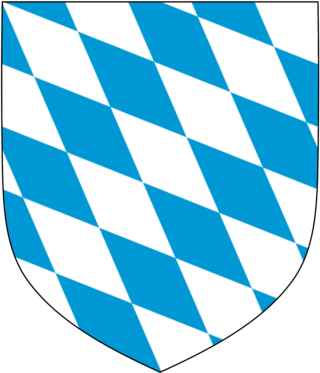
The House of Wittelsbach is a former German dynasty, with branches that have ruled over territories including the Electorate of Bavaria, the Electoral Palatinate, the Electorate of Cologne, Holland, Zeeland, Sweden, Denmark, Norway, Hungary, Bohemia, and Greece. Their ancestral lands of Bavaria and the Palatinate were prince-electorates, and the family had three of its members elected emperors and kings of the Holy Roman Empire. They ruled over the Kingdom of Bavaria which was created in 1805 and continued to exist until 1918.
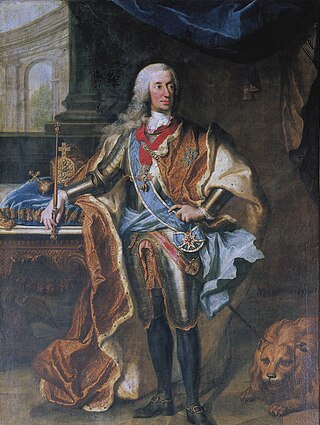
Charles VII was Prince-Elector of Bavaria from 26 February 1726 and Holy Roman Emperor from 24 January 1742 to his death. He was also King of Bohemia from 1741 to 1743. Charles was a member of the House of Wittelsbach, and his reign as Holy Roman Emperor thus marked the end of three centuries of uninterrupted Habsburg imperial rule, although he was related to the Habsburgs by both blood and marriage.
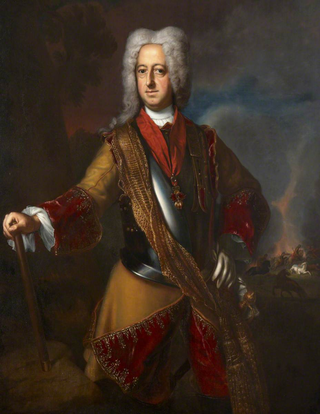
Maximilian II, also known as Max Emanuel or Maximilian Emanuel, was a Wittelsbach ruler of Bavaria and a Prince-elector of the Holy Roman Empire. He was also the last governor of the Spanish Netherlands and Duke of Luxembourg. An able soldier, his ambition led to conflicts that limited his ultimate dynastic achievements.

Ferdinand Maria was a Wittelsbach ruler of Bavaria and an elector (Kurfürst) of the Holy Roman Empire from 1651 to 1679. The elector modernized the army and introduced Bavaria's first government code. Besides encouraging agriculture and industry, he also improved building and restoration works on churches and monasteries since the damage caused during the Thirty Years' War.

The Nymphenburg Palace is a Baroque palace situated in Munich's western district Neuhausen-Nymphenburg, in Bavaria, southern Germany. Combined with the adjacent Nymphenburg Palace Park it constitutes one of the premier royal palaces of Europe. Its frontal width of 632 m (2,073 ft) even surpasses Versailles Palace. The Nymphenburg served as the main summer residence for the former rulers of Bavaria of the House of Wittelsbach.

Maximilian III Joseph, "the much beloved", was a Prince-elector of the Holy Roman Empire and Duke of Bavaria from 1745 to 1777.
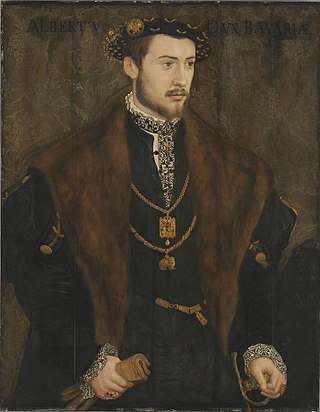
Albert V was Duke of Bavaria from 1550 until his death. He was born in Munich to William IV and Maria Jacobäa of Baden.

The Residenz in central Munich is the former royal palace of the Wittelsbach monarchs of Bavaria. The Residenz is the largest city palace in Germany and is today open to visitors for its architecture, room decorations, and displays from the former royal collections.

The Kingdom of Bavaria was a German state that succeeded the former Electorate of Bavaria in 1805 and continued to exist until 1918. With the unification of Germany into the German Empire in 1871, the kingdom became a federated state of the new empire and was second in size, power, and wealth only to the leading state, the Kingdom of Prussia.

The Schleißheim Palace comprises three individual palaces in a grand Baroque park in the village of Oberschleißheim, a suburb of Munich, Bavaria, Germany. The palace was a summer residence of the Bavarian rulers of the House of Wittelsbach.

Leo von Klenze was a German architect and painter. He was the court architect of Ludwig I of Bavaria.

The Bavarian National Museum in Munich is one of the most important museums of decorative arts in Europe and one of the largest art museums in Germany. Since the beginning the collection has been divided into two main groups: the art historical collection and the folklore collection.
François de Cuvilliés, sometimes referred to as the Elder, was a Belgian-born Bavarian decorative designer and architect. He was instrumental in bringing the Rococo style to the Wittelsbach court at Munich and to Central Europe in general.

The Nymphenburg Porcelain Manufactory is located at the Nördliche Schloßrondell in one of the Cavalier Houses in front of the Nymphenburg Palace in Munich, Germany, and since its establishment in 1747 has produced porcelain of high quality. It is one of the last porcelain producers in the world where every single part is made entirely by hand.

Infanta María de la Paz of Spain was a Spanish infanta. A daughter of Queen Isabella II, she married her cousin Prince Ludwig Ferdinand of Bavaria. She lived the rest of her life in Germany, dedicating her time to her family, charity work and writing poetry. She wrote a book of memoirs: Through Four Revolutions: 1862–1933.

This article gives an overview about the architecture of Munich, Germany.

Franz Anton Bustelli was a Swiss-born German modeller for the Bavarian Nymphenburg Porcelain Manufactory from 1754 to his death in 1763. He is widely regarded as the finest modeller of porcelain in the Rococo style: "if the art of European porcelain finds its most perfect expression in the rococo style, so the style finds its most perfect expression in the work of Bustelli".
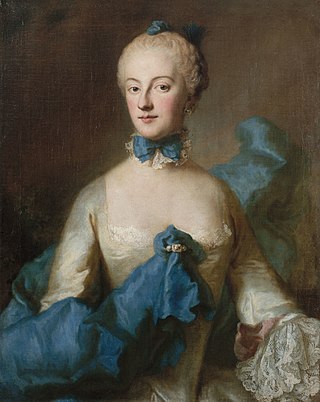
Maria Anna Josepha of Bavaria was a Duchess of Bavaria by birth and Margravine of Baden-Baden by marriage. She was nicknamed the savior of Bavaria. She is also known as Maria Josepha and is sometimes styled as a princess of Bavaria.

Michael Wening was a Bavarian engraver who is known for his many depictions of important places in the Bavaria of his day, including cityscapes and views of stately homes, castles and monasteries. The work has great historical value.
Several monarchs have used golden coaches. These horse-drawn coaches were made of wood and covered with gold leaf, a solid golden coach would be very expensive and so heavy that it would be a practical impossibility.





















